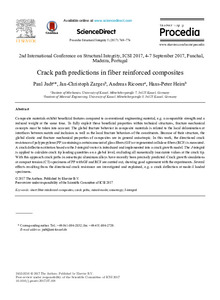Crack path predictions in fiber reinforced composites
| dc.date.accessioned | 2020-12-10T14:08:15Z | |
| dc.date.available | 2020-12-10T14:08:15Z | |
| dc.date.issued | 2017-09-06 | |
| dc.identifier | doi:10.17170/kobra-202012082421 | |
| dc.identifier.uri | http://hdl.handle.net/123456789/12146 | |
| dc.language.iso | eng | eng |
| dc.rights | Attribution-NonCommercial-NoDerivatives 4.0 International | * |
| dc.rights.uri | http://creativecommons.org/licenses/by-nc-nd/4.0/ | * |
| dc.subject | short fiber reinforced composites | eng |
| dc.subject | crack paths | eng |
| dc.subject | mixed mode | eng |
| dc.subject | anisotropy | eng |
| dc.subject | J-Integral | eng |
| dc.subject.ddc | 600 | |
| dc.title | Crack path predictions in fiber reinforced composites | eng |
| dc.type | Aufsatz | |
| dcterms.abstract | Composite materials exhibit beneficial features compared to conventional engineering material, e.g. a comparable strength and a reduced weight at the same time. To fully exploit these beneficial properties within technical structures, fracture mechanical concepts must be taken into account. The global fracture behavior in composite materials is related to the local delamination at interfaces between matrix and inclusion as well as the local fracture behaviors of the constituents. Because of their structure, the global elastic and fracture mechanical properties of composites are in general anisotropic. In this work, the directional crack resistance of polypropylene (PP) containing a certain amount of glass fibers (GF) or regenerated cellulose fibers (RCF) is measured. A crack deflection criterion based on the J-integral vector is introduced and implemented into a crack growth model. The J-integral is applied to calculate crack tip loading quantities on a global level, excluding all numerically inaccurate values at the crack tip. With this approach crack paths in anisotropic aluminum alloys have recently been precisely predicted. Crack growth simulations at compact tension (CT)-specimens of PP with GF and RCF are carried out, showing good agreement with the experiments. Several effects resulting from the directional crack resistance are investigated and explained, e.g. a crack deflection at mode-I loaded specimens. | eng |
| dcterms.accessRights | open access | |
| dcterms.creator | Judt, Paul | |
| dcterms.creator | Zarges, Jan-Christoph | |
| dcterms.creator | Ricoeur, Andreas | |
| dcterms.creator | Heim, Hans-Peter | |
| dc.relation.doi | doi:10.1016/j.prostr.2017.07.168 | |
| dc.subject.swd | Kurzfaser | ger |
| dc.subject.swd | Faserverbundwerkstoff | ger |
| dc.subject.swd | Rissverlauf | ger |
| dc.subject.swd | Anisotropie | ger |
| dc.subject.swd | Jot Integral | ger |
| dc.type.version | publishedVersion | |
| dcterms.source.identifier | EISSN 2452-3216 | |
| dcterms.source.journal | Procedia Structural Integrity | eng |
| dcterms.source.pageinfo | 769-776 | |
| dcterms.source.volume | Volume 5 | |
| kup.iskup | false |
Dateien zu dieser Ressource
Das Dokument erscheint in:
-
Publikationen [85]


